Items
Tag is exactly
Australia
-
2023-10-11
2023: Reflections on travel post-Covid19
We could not travel during the pandemic, but even going to see family near us was a challenge. For the length of the pandemic, I didn't visit my grandparents who lived only an hour away. Being from the family I am, travel is not something we do often due to the expense. If I could travel anywhere in the world, I would pick Australia so I could go to its infamous coastlines. I would like to see the Great Barrier Reef and maybe go on tours about the conservation of our oceans. I would like to take a surfing class and look like a complete tourist as I do so. I'd go to Australia for the water. I used to be someone who needed to take many pictures to "remember" my exploits. However, I learned I spent more time on my phone than in the place I visited. I don't take pictures on vacation anymore; I leave that to my sister and mother. Instead, I try to remember the five senses as I experience the world around me. I have nothing against documenting your trips, but aside from keeping ticket stubs and sunburns, I don't make lasting documentation except in my memory. -
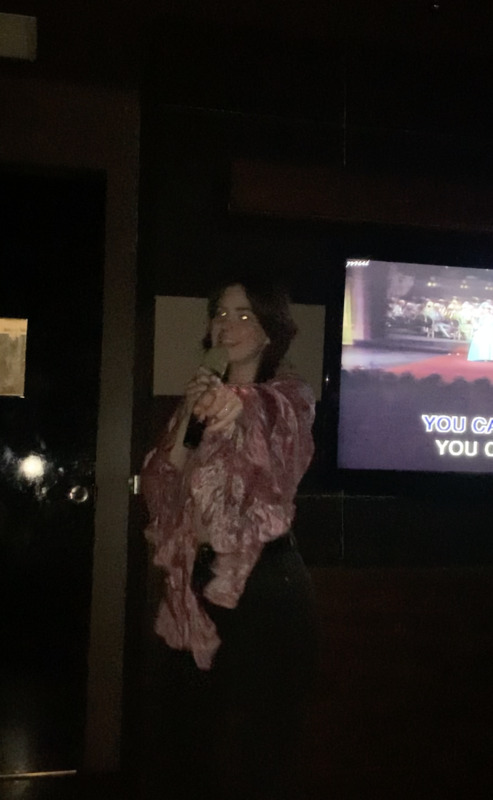 2022-03-01
2022-03-01HIST30060: A Birthday and a Case
For my 21st birthday, I tried to be sensible. We didn't go clubbing, even though they were back open and we hadn't really had a chance to go for three years, and we didn't even go to a bar. 5 of us went to a private karaoke room. We should have been safe. Unfortunately, however, the next day one of my friends texted us that he had tested positive, and pretty soon we were all locked in our apartments. On the 7th day, I tested negative, so, fortunately, was able to go out again. It was a difficult week: I didn't know that many people in Melbourne, and the few I did were equally as infected and were in their own quarantines. I knew no one who could drop off groceries and medication, and online ordering was difficult due to my location. I was incredibly lucky that it was no longer 14 days, but I can certainly say that the 7 were not enjoyable. Fortunately, I was also generally not that unwell (just a fever and a bad cough) and lived in a studio apartment so I had no risk of infecting anyone else. Nevertheless, it was lonely and miserable and I was running out of food. Happy Birthday to me. -
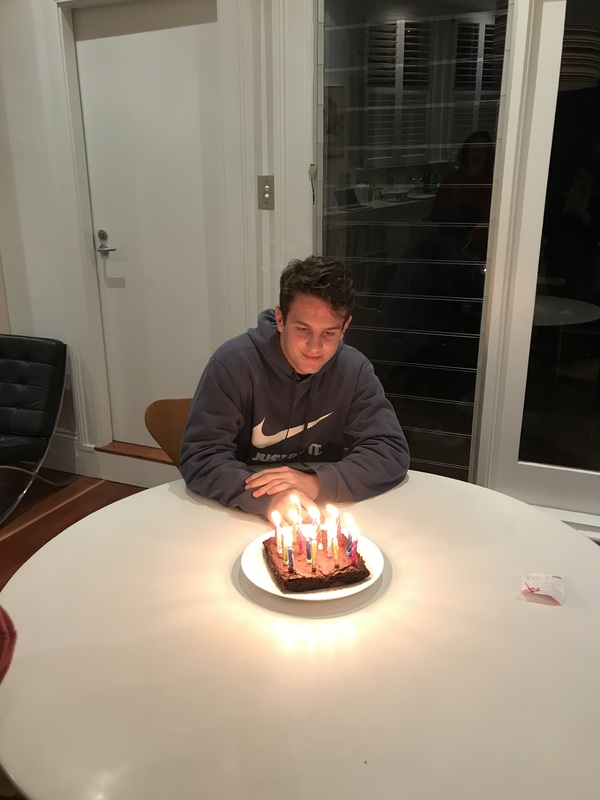 2020-06-04
2020-06-04HIST30060: Loneliness
The past three years have been incredibly lonely. I've included here a picture of my younger brother on his 18th birthday: a picture I find eerily reminiscent of Edward Hopper's Realist paintings from the 40s and 50s. My brother has always been the most popular person in any room, constantly surrounded by friends, a real party animal. But on his 18th, he was alone (with me and my parents) and couldn't celebrate in the way he would have liked. Since then, he has had a makeup party, but it isn't the same. He also finished high school during this period, and god I feel sorry for the classes of 2020 and 2021. It is easy to be sorry for myself, who has only experienced university through the lens of a post-COVID world, but I was fortunate enough to celebrate my 18th with my friends, finish high-school not on zoom, go to schoolies and travel on a gap year before we were prevented by the pandemic. Poor Sam didn't get any of that, and that really makes me sad. -
2021-10
HIST30060: Long Distance friendships
Throughout the past three years, I've spent much time going back and forth between Sydney and Melbourne (largely unrelated to COVID). I went through a fantastic period where I managed to avoid lockdowns in both states (not on purpose, I promise!), but then I ended up doing both Delta lockdowns in Melbourne and then in Sydney (karma). I've never been more grateful for zoom and facetime so I could keep in touch with my friends no matter where I was. -
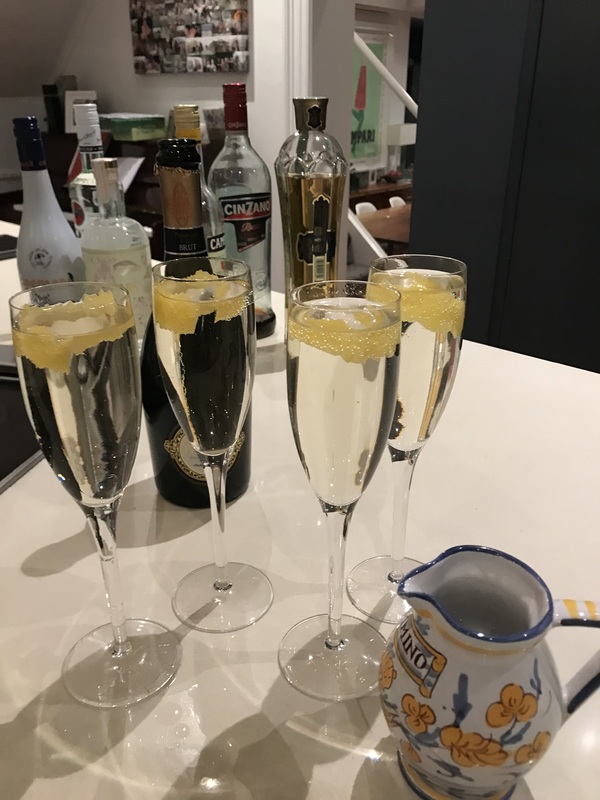 2020-03-31
2020-03-31HIST30060 Lockdown #1: Activities and Alcohol
On 31 March 2022, the first lockdown was initiated in both Melbourne and Sydney. I was in Sydney at the time, having arrived a few days prior from Melbourne as border restrictions were starting to be introduced. I am slightly ashamed to say, now, that I really enjoyed this first lockdown. I hadn't lived at home since 2018, and it was a unique experience to enjoy time together that wouldn't have normally happened. We've always been pretty close, but the lockdown forced an intimacy that we'd never had before (it helped that my teenage brother was required to be at home and boredom had driven him to start having conversations with us again). I think mum and dad were consciously trying to keep lockdown interesting, and soon a weekly cocktail night (with a required lounge formal dress code), bi-weekly painting lessons via zoom and daily yoga with mum, nightly music sessions with dad, lego competitions with the old dusty lego sets, and weekend family walks were introduced. I had never done so much exercise in my life, and yet I had never consumed as much alcohol, either. Even when I lived in a flatshare as an eighteen-year-old. Alcohol quickly became a problem for me, one that I have yet to fully address although I have started to cut down. The taste of wine became associated with fun times with the people I loved, so of course, I loved it. And when the lockdown eventually lifted, I returned to Melbourne nearly friendless (having left before I got the chance to settle in and with little opportunity to meet new people), a cheap bottle of pinot grigio and I became good - if slightly toxic - friends. -
2020-03-22
HIST30060: A Trip to the Zoo
I started at Melbourne University in March 2022, moving all the way from Sydney and knowing no one in Melbourne. I quickly made a group of friends at college, but things were still a bit new and awkward - we were in that stage of a new friendship where you are past small talk but not quite at deep and meaningful. Regardless, we decided to take a trip to Melbourne Zoo on the 22nd of March. It was a great day: the sun was shining and the animals were beautiful. We were joking around and it seemed like we were at the start of a really exciting and close friendship. In the early afternoon, I got a phone call from mum. News had been trickling in over the past month of COVID cases and deaths in Australia, but we still weren't entirely sure how seriously to take the disease, and we were clueless about how it would change our lives. On the phone, mum asked if I had been reading the news. Of course I hadn't. She told me that all non-essential services would be shut down, and that it was likely going to get more strict as the week went on. "I think you should come home. Uni will be online anyway." The next day, I was on a plane back to Sydney, after only having spent 22 days at college. Never fear, though, I was sure it'd all be over soon. -
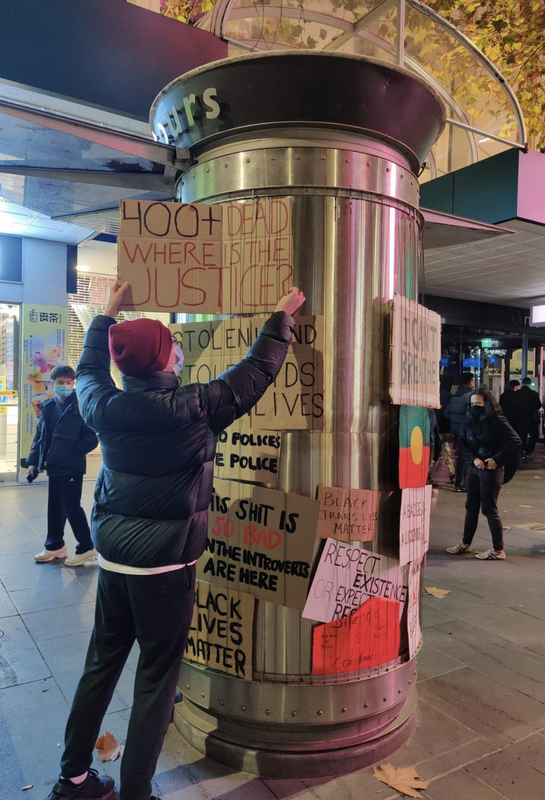 2020-06-06
2020-06-06History within History
HIST30060: This photo was taken at the Melbourne Black Lives Matter protest in June of 2020, it was one amongst the wave of protests taking place across the world sparked by protests in the United States following George Floyd's death at the hands of the police. It was the second protest I had attended and the sheer number of people attending to show solidarity with people of colour in the US and shed light on police issues at home was an inspiring sight despite the harrowing reality of it all. Figures such as the Prime Minister at the time cited health risks as reason to not demonstrate, but this potential of COVID spreading however was consistently weaponised by conservative pundits (despite their consistent calls for lax restrictions). to discredit the movement. -
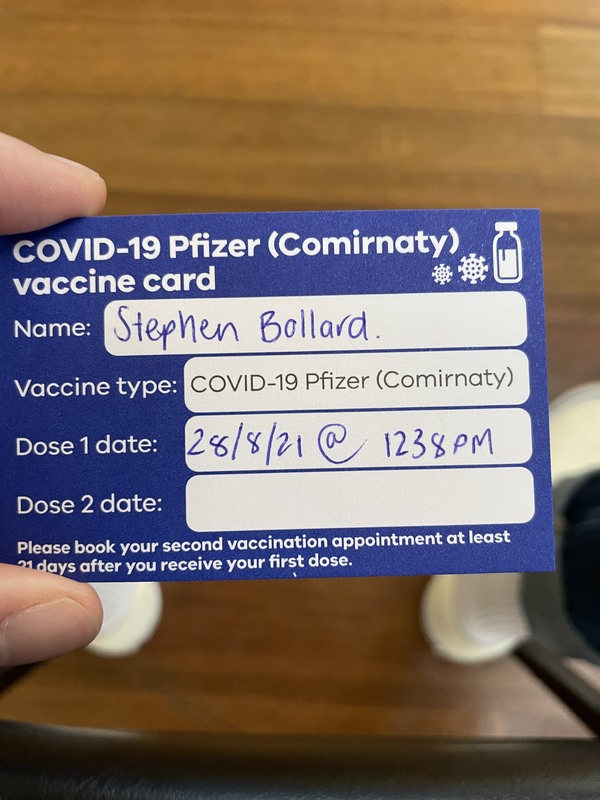 2021-08-28
2021-08-28The First Jab
HIST30060: This is an image of when I was waiting to leave the Royal Exhibition Building following my first vaccination. The experience was not something I was unfamiliar with, throughout high school I received regular vaccinations, the only downside this time was there not being a bowl of lollies to reward myself with as there was during high school. I had been anticipating the worst of symptoms after what I had heard from others, but fortunately all I really got was a stiff arm. This was also amidst the beginnings of the anti-vax movement and protests that we unfortunately are so accustomed to at this point. -
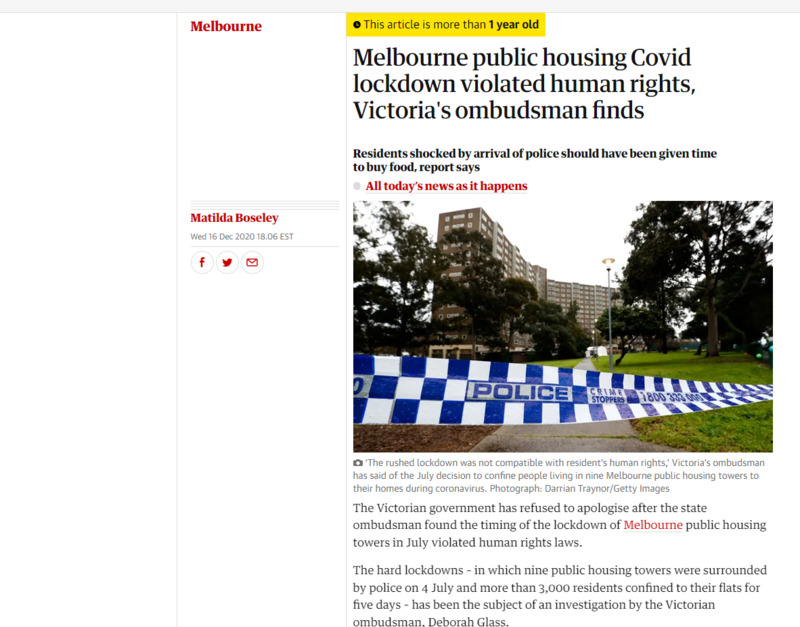 2020-07-04
2020-07-04The North Melbourne Public Housing Lockdown
HIST30060: Just before the second lockdown in Melbourne I was told by my mum that my grandfather and step grandmother had been suddenly without warning placed into a sharp lockdown within the public housing they resided in. The confusion and anger was quickly shared by my family and extended family members, where was the consideration for some of the most vulnerable members of the community, who in some cases cannot speak english? Why were they subject to such harsh conditions whilst those in the wealthy inner east free to enjoy themselves despite their equally high rates of covid? This was noticed by me as well in the harsher treatment of those in the poorer, diverse suburbs of Sydney and Melbourne during some of the worst times of the pandemic. -
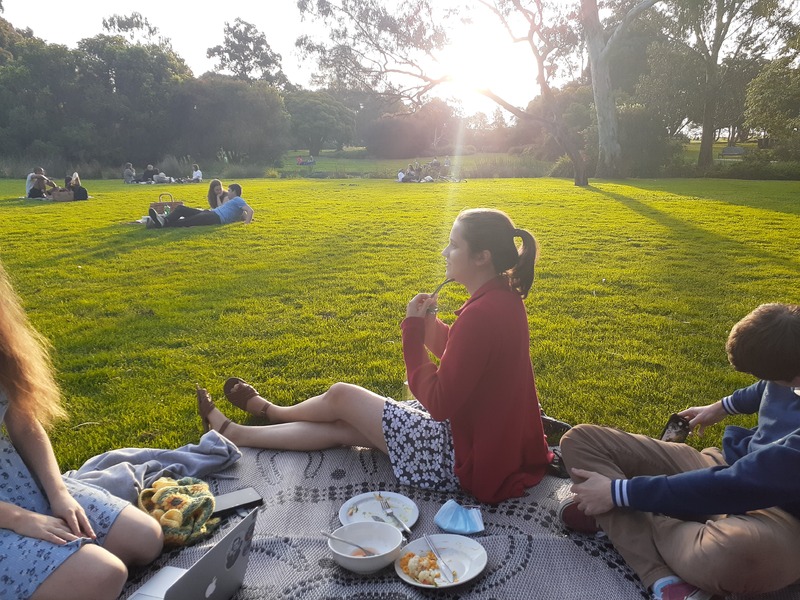 2021-10-20
2021-10-20Picnic in Royal Park
This was a more joyful moment from lockdown. For long periods of Melbourne's lockdown a picnic in the park was the only way to catch up with friends. It became a very popular activity for my friends and lots of other people in Melbourne. Every evening when the weather was good the parks would be full of groups. -
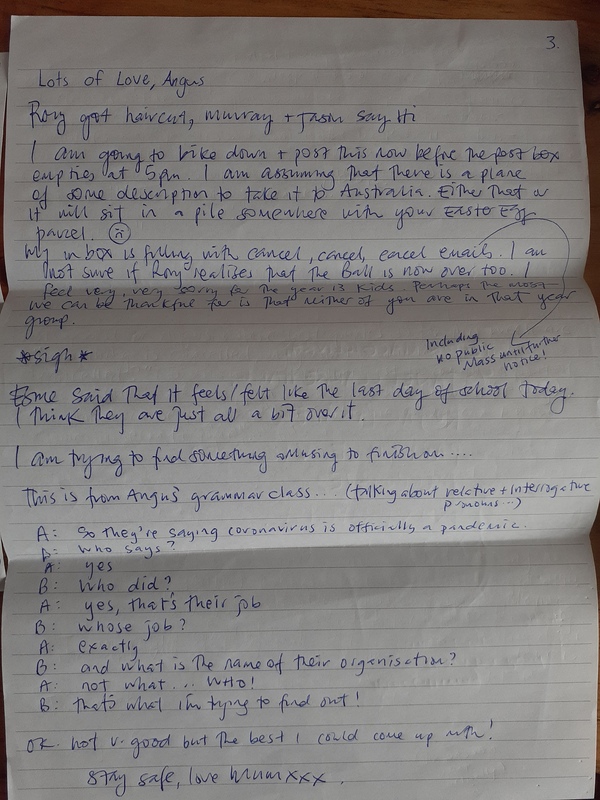 2020-03-20
2020-03-20Letter from Mum
With lots of extra time to spare during the lockdowns, my Mum started writing letters to me as a way to share news. This was a lovely way to stay in touch between Australia and New Zealand, although by the time the letters made it through the very very slow postal system they were weeks out of date. This particular letter from the very start of the pandemic captures the novelty and chaos of the situation very well -- most events are starting to be cancelled, the border between NZ and AU has shut, and everyone is slowly coming to terms with what's happening. -
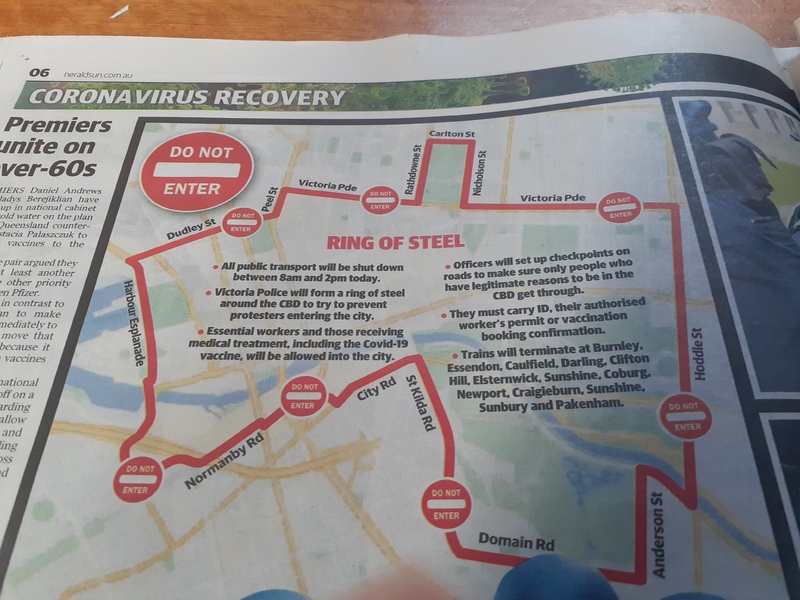 2021-09-18
2021-09-18The ring of Steel
This photo shows a newspaper article published during Melbourne's 2021 lockdown. Following significant anti-lockdown protests in the CBD, the police enacted a 'ring of steel' around the CBD to prevent further protests. I was actually turned around at one of the checkpoints (unaware that the city had been shut) earlier that morning on my morning run. This was one of the most dystopian moments from the whole pandemic and highlighted the lengths the government was willing to take to stop the protests in Melbourne. -
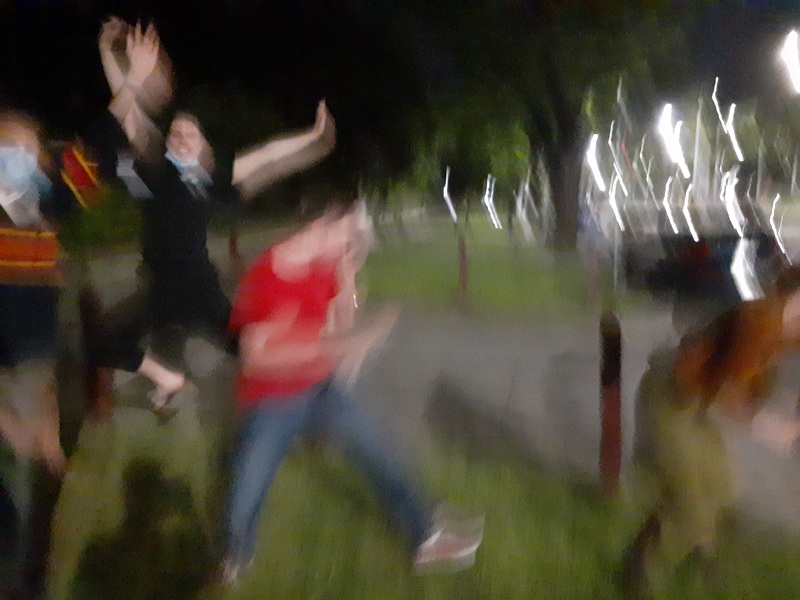 2021-10-22
2021-10-22"Freedom Day"
This photo was taken just after midnight on October 22 2021, after the end of Melbourne's final lockdown. With the curfew lifted and fewer restrictions on leaving home we took the opportunity to come out at midnight and celebrate. This photo captures the excitement of the moment, which finally felt like we coming to the end of the most difficult period of the pandemic. -
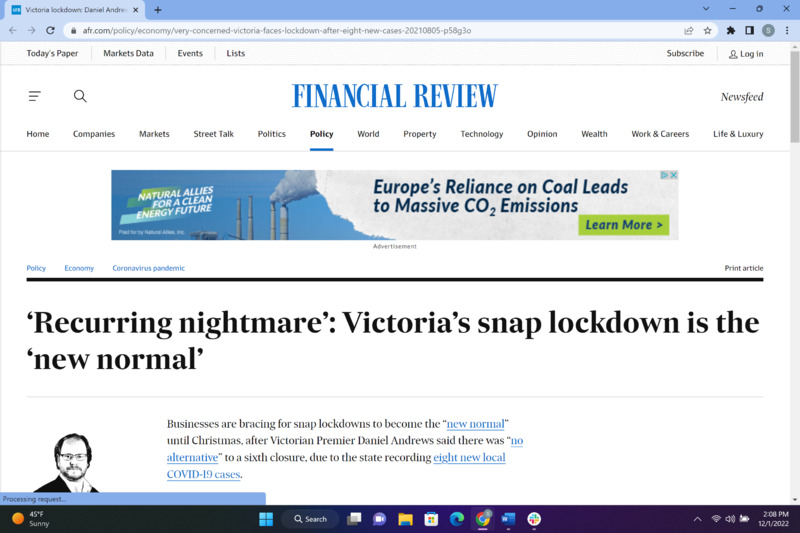 2022-10-30
2022-10-30Silenced voices of the commoner
The recent Covid-19 pandemic has had immense local and global ramifications, especially for us Victorians who have experienced the world’s longest lockdowns. It was a significant worldwide event which will certainly be looked back upon by future generations, just as we have analysed previous historical diseases, such as the bubonic plague. But how should archivists determine which sources, and likewise which voices should be permanently preserved within the historical record? Traditionally, an archive is a collection of documents that archivists have selected to be permanently preserved as sources for future historical or other forms of research. Initially, only scholars with an ambition to conduct historical research had access to archives, but their digitisation and free nature have ensured that anyone is able to access the documents they contain online. However, the process of creating both physical and digital archives is inherently flawed. Archivists have a formidable power to evaluate which sources are “worthy of inclusion”, and simultaneously which ones are not; essentially what compromises the historical record. Therefore, although archivists are characterised as unbiased and impartial individuals, they are inextricably influenced by “societal biases” in their decision-making, as they simply have to select what they personally believe will have value to future researchers. It has culminated in them privileging and prioritising the voices of individuals within positions power, which has indefinitely created “gaps within the historical record” through inhibiting the voices of those without it. Rodney G.S. Carter echoes the problem in asserting that the existence of archival “silences” is the “manifestation of the actions of the powerful”, which has a substantial impact on how marginalised groups produce and likewise form both social history and memory. Ariella Aïsha Azoulay has cautioned readers that “digital archives are no exception”. With this in mind, if we consider the 19-month impact of the pandemic upon Victoria, I am certain that archivists will acknowledge the voices of those within positions of power when determining what sources should be preserved. Of particular importance would be those of primary actors that shaped Victoria’s lockdown experience, most importantly the protagonist of the lockdowns, Premier Daniel Andrews (fig.1). Figure 1. Video of Premier announcing sixth lockdown, cited in Patrick Durkin, “’Recuring nightmare’: Victoria’s snap lockdown is the ‘new normal,’” Financial Review, August 5, 2021, URL: https://www.afr.com/policy/economy/very-concerned-victoria-faces-lockdown-after-eight-new-cases-20210805-p58g3o. I am aware of the threat of “information overload” both real and digital archives currently face with an abundance of available sources, but I would argue that the preservation of major political statements alongside previously supressed voices would be beneficial to any archive created surrounding the Victorian Covid-19 experience. A consideration of the experiences of marginalised voices would be imperative to a future historian, as it would enrich historiography by offering insight into the social-political dynamics of the event, and its psychological impact beyond official government and political documents. I will now consider the value of this “bottom-up approach” in capturing the Victorian pandemic experience from the viewpoint of the common man, me, a historically marginalised group within the realm of archives. I personally wasn’t too concerned about the first lockdown and its stage three and four restrictions as they would “flatten the curve” of infectious cases, providing our health system with the best opportunity to tackle the fast-spreading virus. Life as we know it changed though with only four reasons to leave home; shopping, exercise, caregiving, and work. The café I worked at had to shift to “take away only”, as many others (fig.2). Figure 2. The Food Republic Café, “covid update for customers,” Blackburn, March 23, 2020, URL: https://www.facebook.com/thefoodrepubliccafe. I was still able to work alongside my barista colleague and friend Max which was pretty good, and I was able to perfect my coffee artwork (fig.3). Figure 3. The Food Republic Café, “promotional post during lockdown 1” Blackburn, April 8, 2020, URL: https://www.facebook.com/thefoodrepubliccafe. I was also able to continue exercising and riding my bike, but I wasn’t able to see or visit any friends or family, which initially seemed like a fair sacrifice to make for the health and wellbeing of all Victorians (fig.4). Figure 4. George Vesnaver, Selfie on bike ride, April 10, 2020, photograph, Main Yarra Trail, Melbourne. However, after being continuously plunged in and out of lockdowns by the time the sixth one came about, I was very angry to say the least as representative within my covid journal entry (fig. 5). Figure 5. George Vesnaver, Covid Journal Entry, October 27, 2022, photograph, Kew East, Melbourne. Laura A. Millar’s observation that “the concept of evidence” must be broadened as opposed to its current restrictive and rigid format adopted by archivists has reaffirmed my belief that my experience and that of other regular people should not be forgotten. My sources may just seem like information to an archivist because of their form, but they are filled with evidence of this historic moment. Their eternal preservation within an archive would serve anyone wanting to write about the Victorian Covid-19 experience in the foreseeable future. For example, figure 2. would enable one to see how government information was disseminated via social media; the confirming and likewise conforming of political decisions. Figure 3. would reveal the way in which people adapted to Victoria’s first initial lockdown via humour, helping us remember attitudes towards the past event. Figure 4. would showcase a sense of normality during unprecedented times, through an ability to continue exercising. But most importantly the response depicted in figure 5. towards figure 1., a first-hand account of the psychological impact of the endless lockdowns instigated by those with political powers. Winston Churchill once said that “history is written by the victors”, so considering those with and without power survived the pandemic it seems only fair that all our voices should be recognised in the historical record. -
 2021-08-08
2021-08-08Revisiting the family archives - HIST30060
In isolation, I found myself coming closer to my family. I was living in Melbourne at the time, away from my home in Tasmania, but maintained constant connection via video calling and messaging my family. One way I connected with home was by sharing old photos with my sister. This is one she sent me while I was in lockdown. It was taken around 2008. Trawling through thousands of old photos was an easy way to keep occupied during lockdowns, and I’m partially glad that COVID gave me the free time to do so as it was a fun way to bond with family and massage out the homesickness. -
 2021-09-16
2021-09-16Escaping Melbourne - HIST30060
This is a picture of Melbourne Airport (Tullamarine)’s Terminal 4. I flew out of Melbourne to get home to Tasmania just days before rising cases of the Delta variant forced state governments to shut borders once again. I remember the surreal feeling of passing through the airport then. Without the rush of people, the place felt gigantic. My eyes, typically drawn towards the way I needed to go, were able to refocus towards the ceilings, pillars and billboards. It felt like standing in a cathedral. As I was dwarfed by the sheer size of the terminal, I reflected on how COVID was reshaping billions of lives and world history as a whole too. -
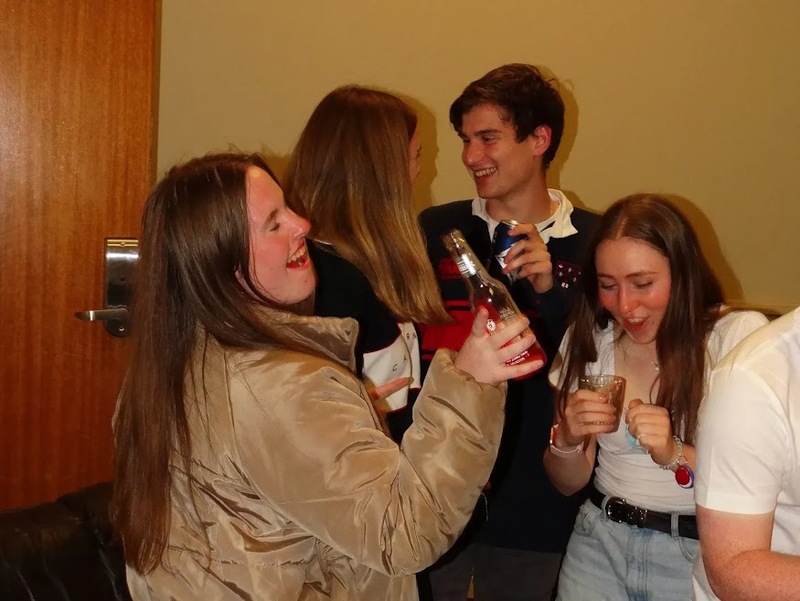 2021-09-15
2021-09-15Going home party - HIST30060
When the new Delta variant led Melbourne’s COVID cases to explode over the second half of 2021, smaller states looked set to shut borders with Victoria. Consequently, I had to leave my new home at in Melbourne to get back to Tasmania in late September. Not knowing when we’d all see each other again, my flatmates held a small party for me. We stayed up until 4am. This is a picture one of them took at the event. -
 2020-04-04
2020-04-04HIST30060: Daniel Andrews' Facebook Post
This is a screenshot of a Facebook post made by Daniel Andrews’ public page on 4th April 2020. This post exemplifies the Victorian Premier’s ability to co-opt social media trends in promoting his own political agenda. Popular in early 2020, the meme followed the template of “Good morning to everyone except,” followed by exclusion of a relatively a niche social group. This screenshot illustrates the subtle use of social media as propaganda by the Andrews government. Andrews’ social media pages are seldom thought of as such, as the skill of his social media team has allowed him to maintain a popular and likeable social media persona. In an age of ubiquitous social media use, the Andrews government has used social media very effectively to protect its legitimacy and justify its methods. For example, the screenshot highlights the use of guilt by the Andrews government to legitimise health restrictions. The government consistently stressed that the pandemic restrictions were for the benefit of the public and necessitated complete compliance. Those who rejected health advice were endangering the entire community and “putting everyone at risk.” This post therein encapsulates sophisticated government propaganda and the co-opting of social media for political purposes. I selected this post as someone influenced by the sophisticated campaign of government messaging. It lead me to resent rule-breakers and see the prolonged restrictions as a legitimate use of government authority to protect the public. As someone who entered the pandemic as a supporter of the Labor Party and Daniel Andrews personally, I no longer think the severity and length of the lockdowns were necessary. Yet, his social media presence certainly made him likeable, funny, and relatable at the time. -
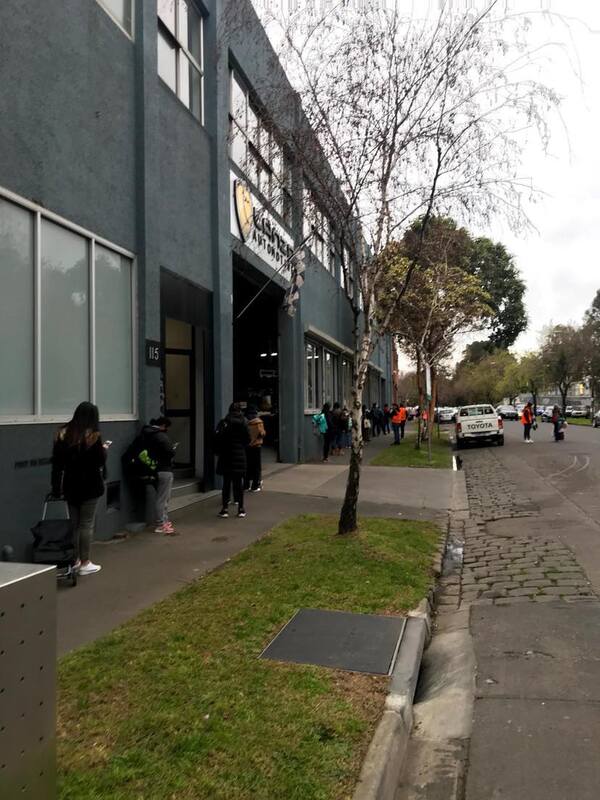 2020-08-07
2020-08-07HIST30060: Food Relief Centre Queue
This is a photograph taken of a queue to enter a food relief centre in South Melbourne in August 2020. The queue was several hundred metres long. As lockdowns began to ravage Melbourne, most businesses were forced to close, resulting in many people losing their jobs. Where this food relief centre had services around 100 people at the start of 2020, this number swelled to over 2000 by the height of the pandemic. Among the most vulnerable demographics affected by the pandemic restrictions were international casual workers and students. Where citizens were eligible to apply for various emergency relief payments, such as Job Keeper or Job Seeker, migrants did not have access to these resources. This food bank only required a form of identification to register the recipients. Several pandemic related restrictions are shown in this picture. The recipients are socially distanced, standing on makeshift markings spaced 1.5 metres apart by government restriction. They wear masks; a government requirement both indoors and outdoors at the height of the pandemic in Victoria. The food bank volunteers wear neon orange high-visibility vests and hold QR codes for the recipients to register on their own devices. I have volunteered at the food relief centre since 2020, performing the same role as the volunteers in the photograph. Where mainstream historical narratives and media may focus on how the lockdowns affected citizens, it is important to remember how migrants too were affected by the pandemic and had little to know support from the Australian government. -
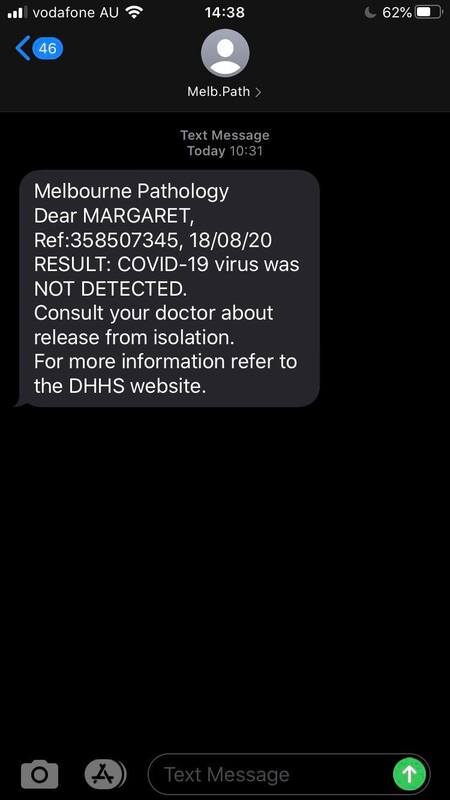 2020-08-18
2020-08-18HIST30060: Negative Test Result
This is a screenshot of a negative PCR test result from August 2020. At this time, test results would typically take 24 hours to process, with the government requiring that the patient isolate until they received the result of their test. I, like most residents in Melbourne, suffered a profound emotional impact from the bombardment of public messaging about the pandemic. The advertising campaigns by the state government as well as opinions expressed on social media suggested that a failure to follow health protocols would result in tremendous negative effects. For example, failing to get tested could be the reason that someone's grandmother died from exposure to the pandemic. With such high stakes attached to my everyday behaviour and compliance to health orders, whenever I felt even slightly unwell, it would trigger a barrage of intense anxiety. The health order to self-isolate for a week after a positive test result, as well as the Andrews governments' policy of reopening contingent on the number of positive test results in the community, further increased anxiety around any form of cold symptoms. To the day, this image evokes feelings of fear and relief. Something so mundane as a text message represented either a ticket to freedom or a binding health order. In this case, the text message represented a reassurance that my sickness was the regular, boring sort, and that I was not an accidental killer of grandmothers. It represents the use of everyday technology, both sophisticated and mundane, in the pandemic response. -
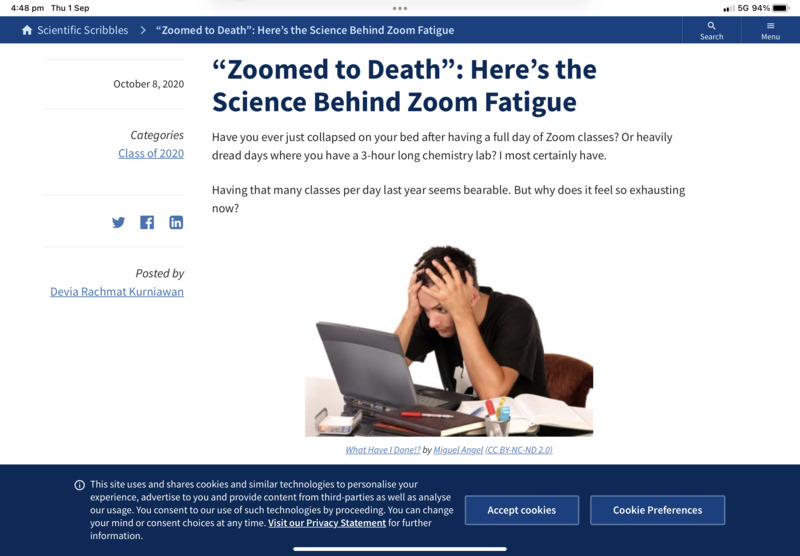 2020-10-08
2020-10-08“Zoomed to Death”: Here’s the Science Behind Zoom Fatigue
Students all over Australia experienced struggles with the pandemic affected learning environments, one of the most challenging at the a University of Melbourne was the use of Zoom calls for learning and how it impacted motivation to learn and overall fatigue. -
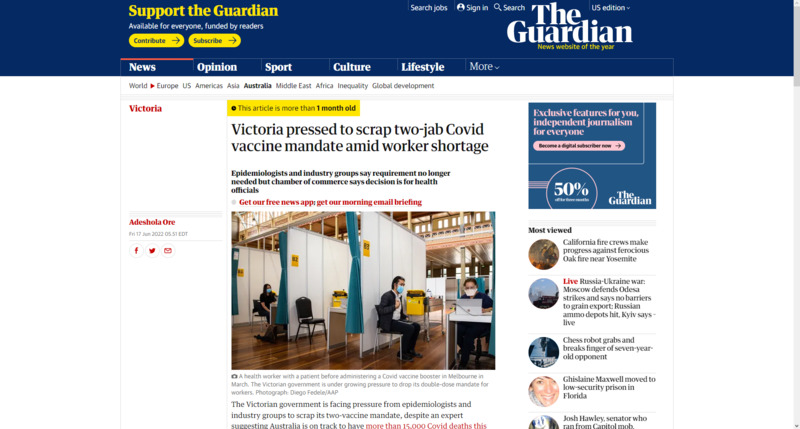 2022-06-17
2022-06-17Victoria pressed to scrap two-jab Covid vaccine mandate amid worker shortage
This is a news story from The Guardian by Adeshola Ore. The Victorian government has been pressed to stop the two-jab vaccine mandate due to a worker shortage. "While some industry groups have called for the two-dose mandate to be abolished to help ease the skilled workers shortage, the Victorian Chamber of Commerce and Industry (VCCI) said the decision was up to health officials." "Almost 95% of Victorians aged over 12 have received two doses of a Covid vaccine." -
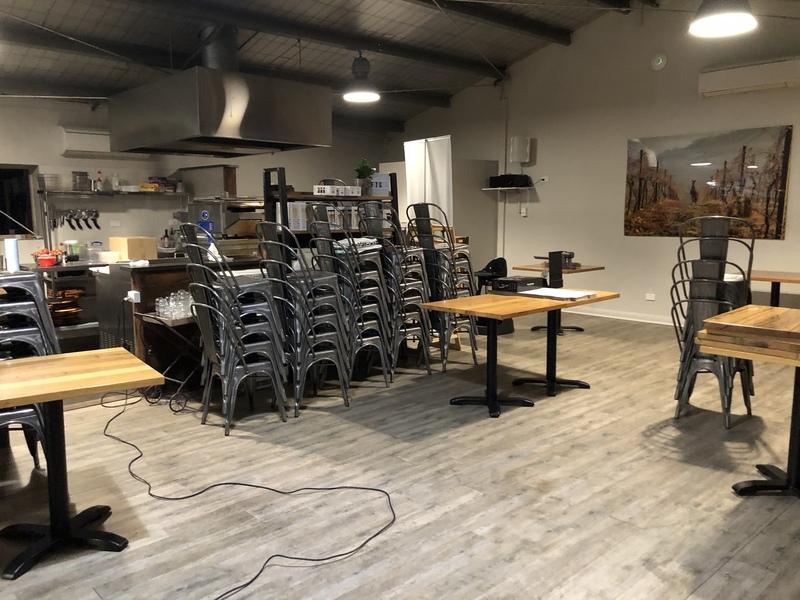 2021-10-09
2021-10-09HIST30060 Small business ownership during lockdown
My parents own a small restaurant, and as such, were largely impacted by Melbourne’s various lockdowns. The restaurant is located on the outskirts of the Yarra Valley, in a peri-urban region known for tourism. As such, the location of the restaurant is isolated from major townships and shopping complexes. We were open for takeaway at the start of the pandemic, however when the 5km rule was introduced (in metropolitan Melbourne residents were only allowed to travel a maximum of 5km from home) it meant that only our very near neighbours were permitted to pick up takeaway; remaining open was thus unviable. As we transition into a post-COVID world, my Mum – the manager – in consultation with other local restaurant owners has reflected on common anxieties about the spread of COVID-19 and the process of verifying/mandating that each customer is double vaccinated (as per state government legislation). Will we receive resistance from anti-vaxxers? Will these rules impact how many customers we receive? There are many unknowns. Pictured is the interior of the restaurant – which has been packed up for nearly a year now – and our check-in QR code which customers must scan before entering. -
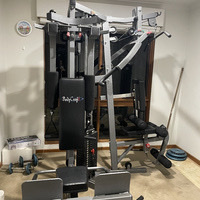 2021-06-06
2021-06-06HIST30060 Makeshift gym
Exercise became a large part of my life in the pre-pandemic world. It assisted me in maintaining good mental and physical health whilst I navigated university life, work life and social life. I signed up to a gym and regularly attended group fitness sessions. Having found this therapeutic outlet, my anxiety flared up when gyms were closed at the start of the pandemic. I think that many people, like me, would have struggled with the inability to undertake their fitness regimens – for social, physical or mental health purposes – during the pandemic. My Dad was also one of these people – he went out and bought a home gym for us to use (which we crammed into our spare room). In 2021, I thought the pandemic was over, however was still very appreciative of the set of dumbbells I received for my birthday. Sure enough, we were back into a lockdown soon after. Thank goodness for those dumbbells – they’ve kept me sane, more than I’d like to admit! -
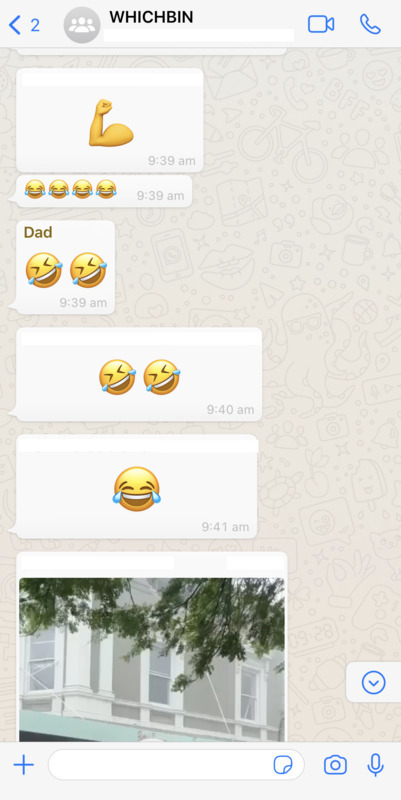 2021-09-10
2021-09-10HIST30060 Group-chat shenanigans
Lockdown shifted the nature of community dynamics in our local area. We live in a peri-urban region on the outskirts of the Yarra Ranges; as such, neighbouring properties are separated by large swathes of Australian bush. This can be isolating at times; it’s very different to suburban living. Our street (which spans about 7kms) and adjacent streets have a WhatsApp group chat named ‘Fireguard’, which allows residents to share information about fire safety, planned burn-offs and emergency warnings. However, during lockdown the chat was increasingly used for the purposes of socialisation. Suddenly, distant neighbours began sharing jokes and engaging in conversations about lockdown living, through the chat. The chat became a site of social interaction that the members of our area probably didn’t realise they needed, until they did. We eventually decided to create a separate chat for general/social purposes only, the title ‘WHICHBIN’ constituting a friendly inside joke about one particular chat member who never fails to ask, “which bin?” she needs to put out for collection each week. -
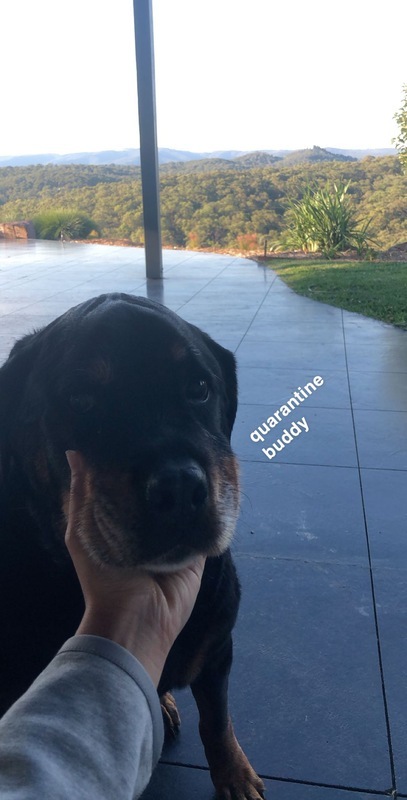 2020-12-18
2020-12-18HIST30060 The importance of pets during the pandemic
State-sanctioned restrictions changed the way in which individuals/groups were able to process emotional experiences, such as grief. Our family dog –Bonnie – was a saving grace during lockdown. She was my “quarantine buddy” and made each day a little brighter. My family went through a tough time around Christmas; Bonnie was becoming progressively sicker, and we had to make the decision to put her down. When we arrived at the vet clinic, we discovered that our family who had attended – Dad, Mum, my brother, myself and my grandparents – could not all wish her farewell together; only two of us were allowed in the waiting room with Bonnie at once, due to COVIDSafe density limits. My parents went in together, and then my grandparents, and then my brother and myself. I’m glad that my brother and I got to share the experience of saying goodbye together; Bonnie was a fundamental part of our childhoods, thus we shared a similar type of grief. However, the ability to farewell this member of our family as a family unit was impacted by COVID-19. Pictured is a “Snapchat” of Bonnie that I sent to my friends, and a picture of her at the clinic. -
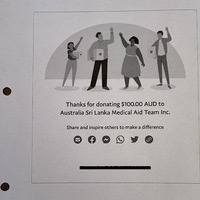 2021-05-06
2021-05-06HIST30060 Practicing religion during lockdown
Through discussions with my grandmother, I reflected on an interesting intersection between the impact of the lockdown on both older Melburnians and faith communities. My grandmother is a practising Buddhist; a key annual ritual that was unable to be undertaken in 2021 was the commemoration of my grandfather’s death anniversary, typically observed by preparing food and inviting friends and relatives to our home for a ceremony (known in Buddhist ethics as sharing ‘merits’ with the deceased to send them good fortune). As this gathering was not permitted, my grandmother shared ‘merits’ with my grandfather by instead donating to a charity; I think that such as example highlights the mediation between religious practices and natural sciences, in the context of this health crisis. Pictured is the receipt from my grandmother’s donation; sharing her wealth by committing this good deed was important to her during this time. -
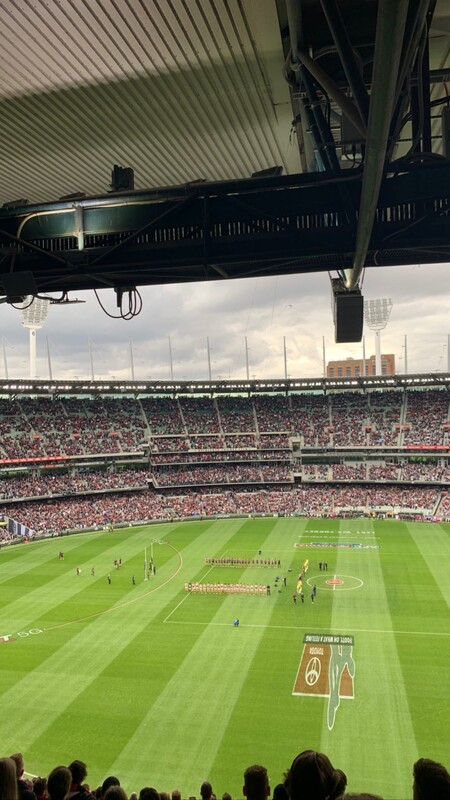 2021-04-25
2021-04-25HIST30060 Anzac Day
This is an image from the Anzac Day match at the MCG on the 25th of April 2021. Returning to the MCG for AFL matches was one the more ‘normal’ things we could do at the start of the year. When this game was held, it was the largest crowd recorded at a sporting event in the world. The Anzac round is my favourite round of the year and it felt amazing that footy was back and Melbourne was covid free. A couple weeks later the AFL team I support - the Collingwood Magpies - saw its lowest ever recorded attendance at the MCG since 1940, as AFL returned, many of their supporters chose not to attend games, this may be due to how our team was performing or the capacity limits. Just looking back at this photo in lockdown makes me question how we thought we were ‘back to normal’ at the start of the year, when we were so far from it. -
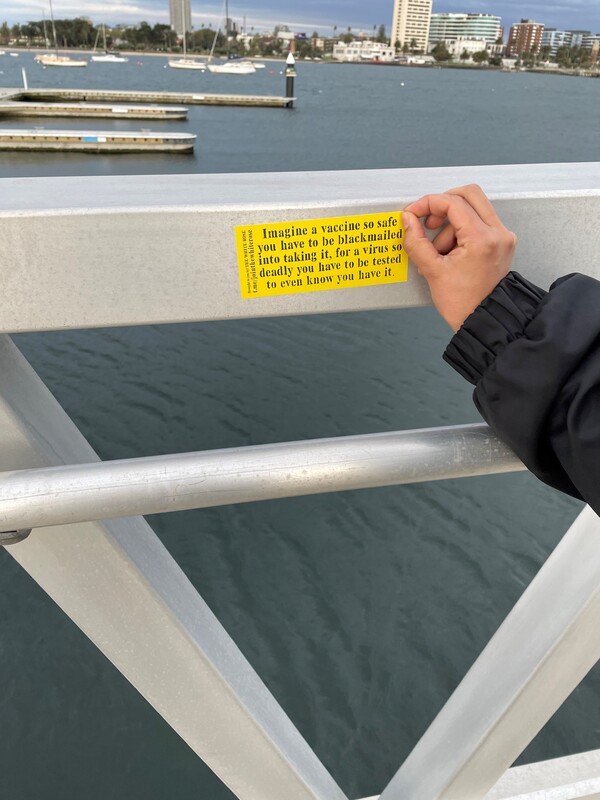 2021-09-19
2021-09-19HIST30060 Misinformation
This image I took down the St. Kilda pier. Someone had left various stickers that spread misinformation about covid, lockdowns and the vaccine. My friends and I decided it was best to remove these stickers as they are quite harmful. Living in Melbourne it has been so tiring watching ‘freedom protestors’ and people from far-right groups constantly spread misinformation and attend protests during stage 4 lockdowns (where we can only leave the house for the essentials). The fear-mongering these groups do its quite upsetting as I’ve seen my friends and some distant family members share their information on social media. The ‘anti-vaxxers’ and covid deniers even compare wearing a mask, getting vaccinated and being in lockdown to the Holocaust, which is so harmful and upsetting -
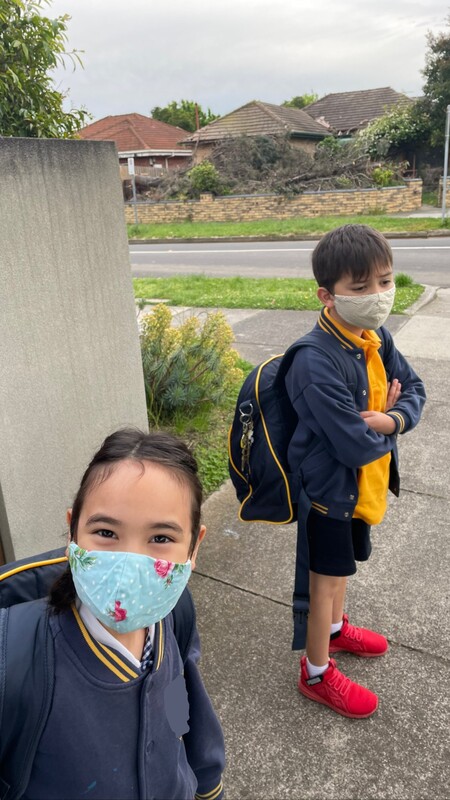 2021-10-21
2021-10-21HIST30060 Back to School
This is an image of my younger siblings on their first day back at school! My sister started her first year of school last year, so her entire schooling experience has been broken up into periods of online learning. Everyone in her grade 1 class is struggling a bit as they haven’t had a proper experience of going to school. It is not mandatory for grades prep to 2 to be wearing face masks in class; however, my brother has been admitted to the hospital a couple of times when he has a bad asthma attack so we’re trying to be as careful as we can. As you can see there are mixed feelings attached to going back to class, both were excited to see their friends and teachers, but will miss spending the whole day at home with dad and me. -
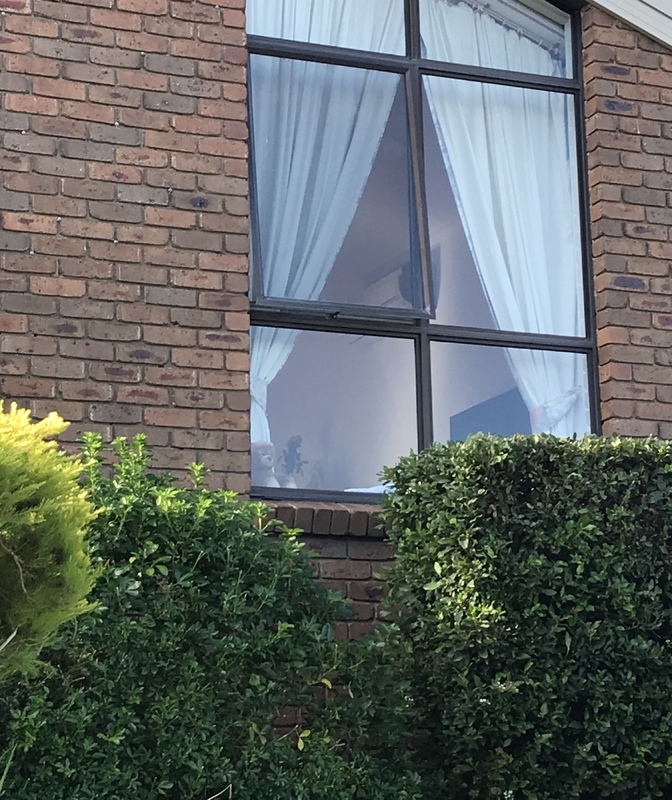 2020-04-13
2020-04-13HIST30060 - Easter Hunt: Bears Hiding in Windows
These two photographs were taken in April 2020 during Easter. My neighbourhood decided to come together and do something special for the kids - many families participated and placed teddy bears on their windows facing the footpath. This created a 'Bear Hunt' trail for children and their families to participate in. I decided to take a walk around my neighbourhood to experience this for myself and it has become one of my most memorable moments during the COVID-19 lockdown. Many children and their families were walking around socially distanced, and strangers I had never seen before would wave at me across the streets and exchange greetings. The sense of community was really strong and it felt like everyone was together, in solidarity, even amidst the toughest of times. -
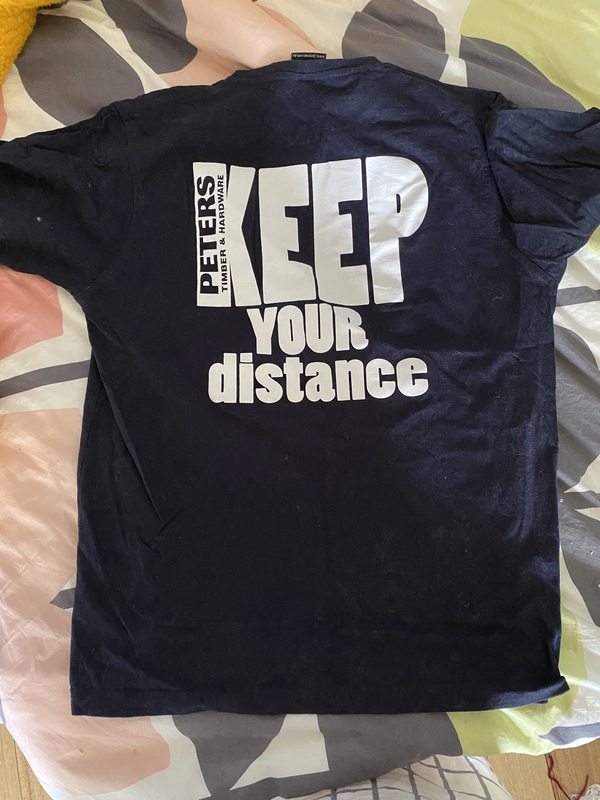 2020-07-15
2020-07-15HIST30060: KEEP YOUR distance!
HIST30060: This photo of the back of my work uniform shows how workplaces were affected by the restrictions of the pandemic. Hardware stores were able to stay open to trade customers and for "click and collect" purchases during Melbourne's lockdowns, which meant a change to our normal work routines. Staff were charged with the responsibility of making sure customers wore masks, checked in with the QR codes and practiced social distancing throughout the store. These necessary rules were challenging to enforce sometimes and customers could often be disgruntled and unhappy with these changes. This message on the back of the uniform was in keeping with the atmosphere of working during this period and symbolises our adjustment to "covid normal" practices. -
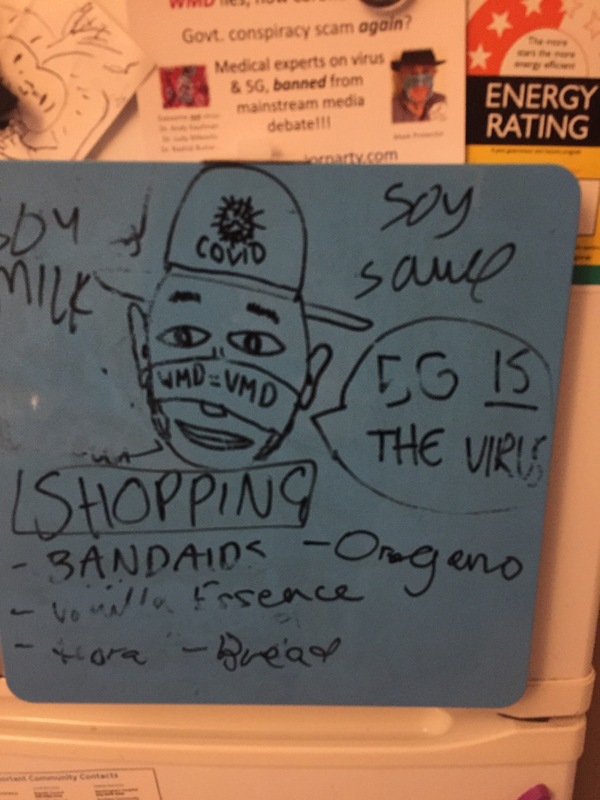 2020-08-10
2020-08-10HIST30060: 5G Conspiracy
(HIST30060) This photo is of a drawing by one of my housemates of part of a postcard that we received during the first lockdown in 2020. Conspiracy theories surrounding the virus and 5G had just begun to spread during Melbourne's first lockdown, yet my housemates and I felt quite removed from this phenomenon as our social circle mainly consisted of other young, progressive students who were very against these sorts of theories. Receiving this postcard in the mail however, was quite a shock, knowing that people close to us in our area of Melbourne shared these beliefs. Whilst we initially found the image of a man with a hole cut out of his mask humorous, hence the drawing, we were also astounded at the intensity of the covid-scam propaganda. This also marked my first taste of the bitter divide that was to come between pro and anti vaxxers in 2021. -
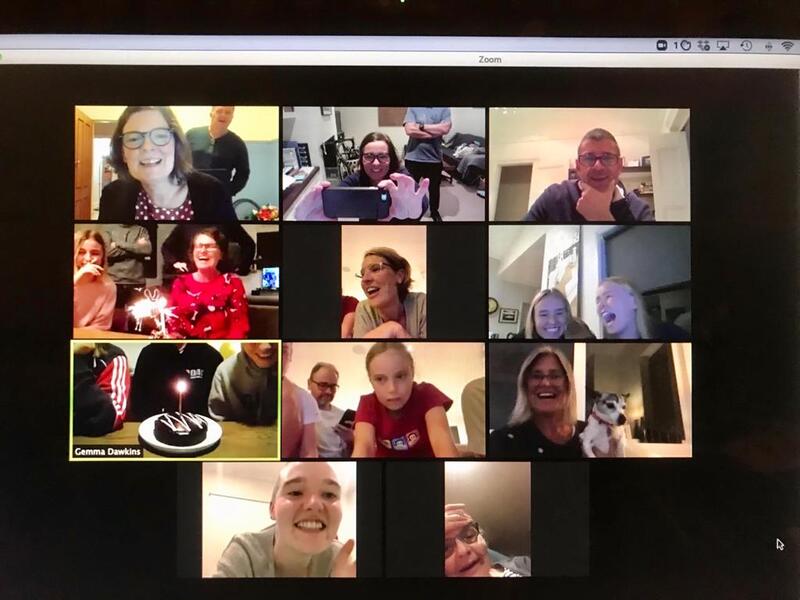 2020-04-02
2020-04-02HIST30060: Birthday Zoom!
HIST30060: This screenshot of my auntie's birthday celebration on zoom would be a familiar scene to many. This is one of the many ways my family had to adjust to "covid normal". Birthdays always involve a big gathering and a way for everyone to catch up; losing this was really disheartening . However, this photo also represents the resilience of my family in still being able to find a way to be together, even if zoom felt like a poor substitute. Zoom was and still is a crucial part of many people's lives in the pandemic, yet can create a barrier for those who find the interface challenging to use. Elderly members of my family often found zoom quite tiring and hard to use, creating a further barrier to connecting in lockdown. -
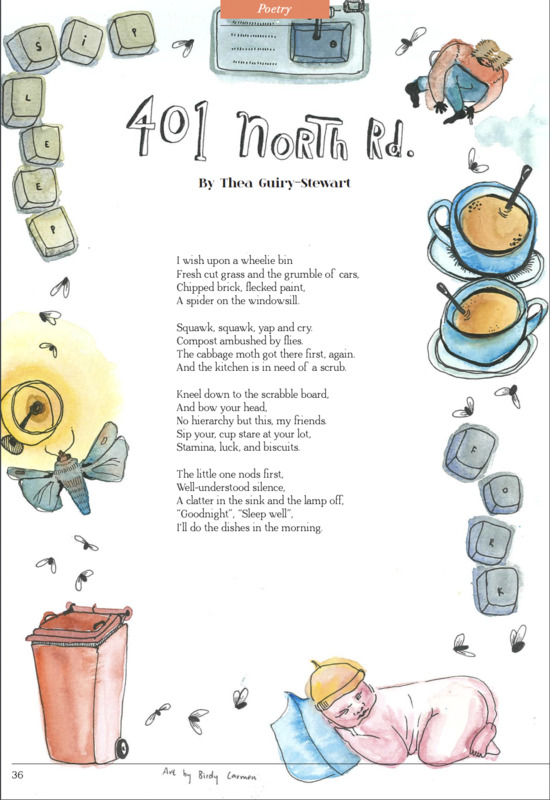 2021-09-29
2021-09-29HIST30060: Lockdown Musings
This poem was written in May of 2020 during Melbourne's first official lockdown. This poem was written for a University assignment and was published in an anthology in September 2021. I wasn't deliberately trying to write about the pandemic in this piece, however the long days at home spent with housemates, playing board games and watching reality tv, crept into the piece. This medication on the beauty of domestic mundanity reflects how people had to adjust their perspectives on constantly being home. Unless there was a way to find joy and beauty in the everyday it would have been impossible to get through the tough, lengthy restrictions. -
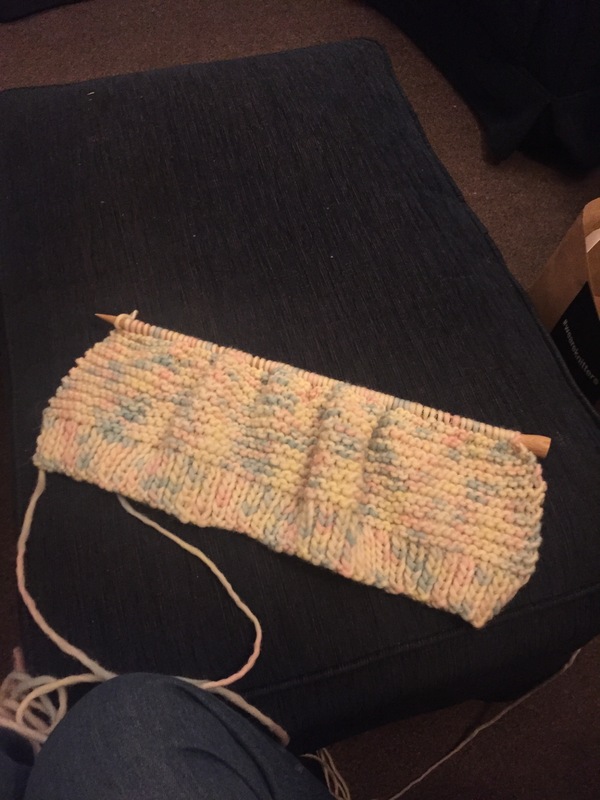 2020-08-22
2020-08-22HIST30060: Lockdown Knitting
(HIST30060) Like the people that learnt to bake sourdough, completed dozens of puzzles or took up running; I decided that learning to knit would serve to occupy the time between work and study that didn't involve Netflix. This represents how I benefitted in part from Melbourne's lengthy lockdowns, as opposed to people who may have struggled with added responsibilities like guiding children through schooling on zoom or working in healthcare on the frontlines of the pandemic. Knitting also acted as something I could mark my time with; this picture was taken on my birthday when I decided to make my first jumper. Instead of remembering this time as purely disheartening, with the news of a re instating of lockdown in late August 2020, I also remember it as an exciting period where I really honed in on my new craft. -
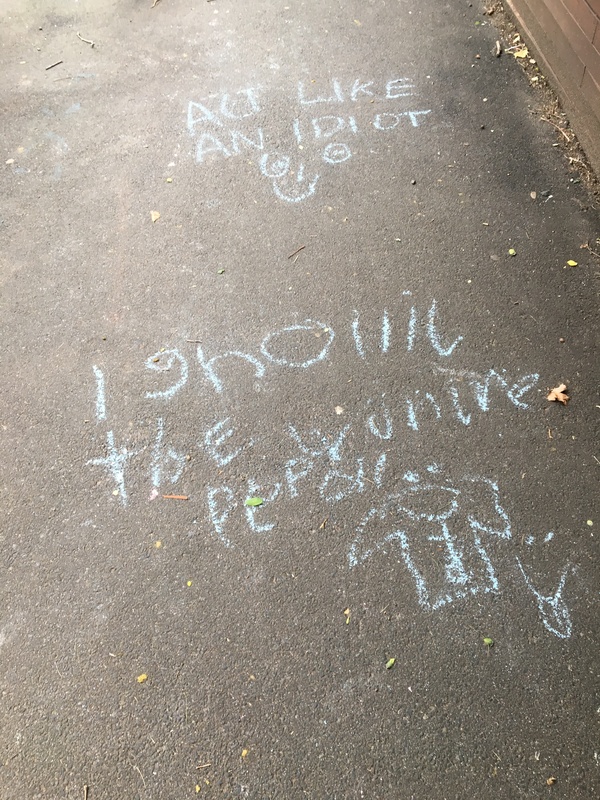 2020-04-12
2020-04-12Joy on the Pavement
During Melbourne’s first lockdown in 2020, movements to bring joy to the few remaining active public spaces were organised over social media and among local communities. One trend was pavement art that encouraged the walker to “laugh”, “pick up some rubbish” and “strike a pose” on their permitted hour of exercise. These minor artworks expressed an optimism in community strength at the early stages of the pandemic; they expressed, too, a resilience in Melbourne’s identity as a city of art and culture. By the second lockdown in August 2020 the chalk had been washed away and there was little to replace it. Creating community from inside our own homes, it turned out, was much harder to sustain than anyone had imagined. Submitted for University of Melbourne HIST30060, Semester 2 2021. -
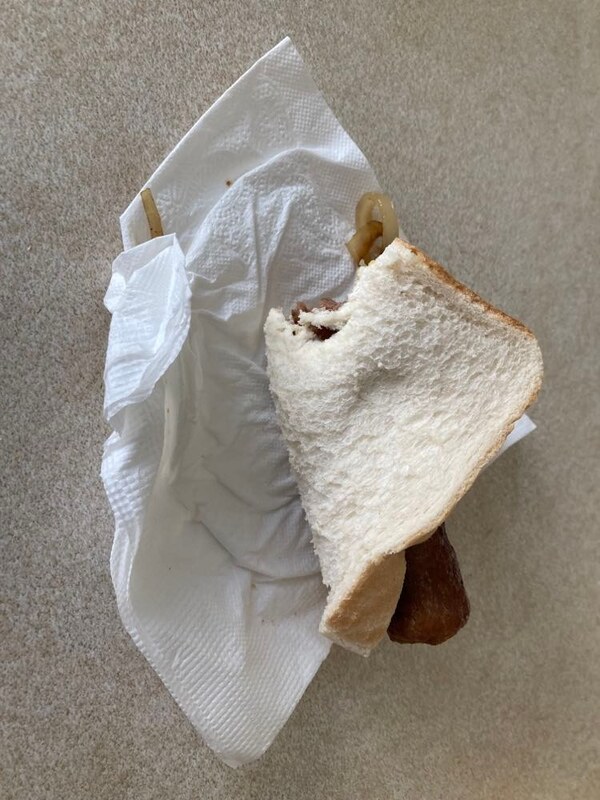 2021-11-02
2021-11-02Bunnings Sausage on Cup Day
Melbourne Cup Day, 2021. My family has always made time for good food and good drink during the races. Today, though, started with a barbecued sausage in white bread from Bunnings. The return of the community fundraiser sausage sizzle at Bunnings hardware stores has been the subject of memes and jokes throughout yet another long winter lockdown: it is, so the joke goes, the best symbol of freedom we have. The sausage sizzle has a peculiar cultural import in Australia. In recent years, the election day tradition of fundraising has been called the “democracy sausage”, a signifier of the national democratic culture. The “freedom sausage” seems to be in the same category. After months at home, it is the simple things like browsing pot plants and lumber that are most appealing. Only select Bunnings, apparently, were approved to resume sizzles this weekend, so I was glad to take advantage of it. Submitted for University of Melbourne HIST30060, Semester 2 2021. -
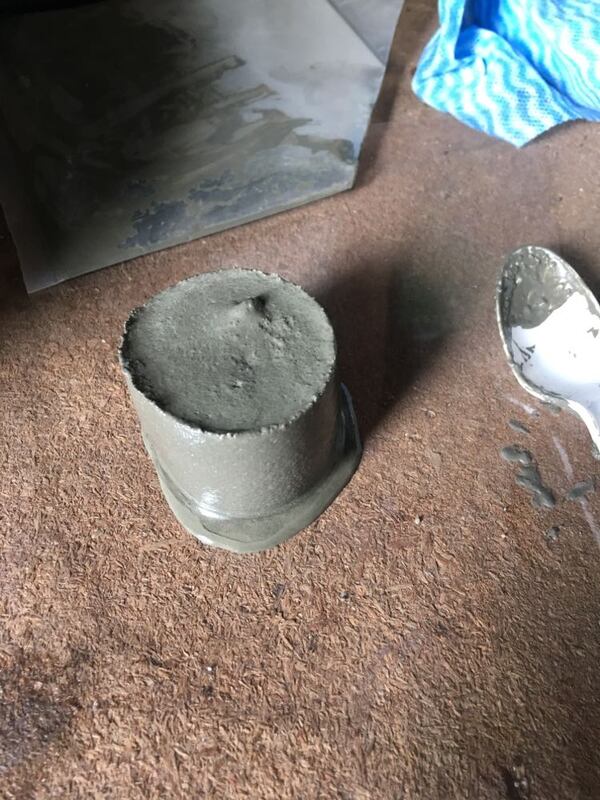 2020-11-01
2020-11-01Concrete Engineering at Home
In 2020, the Faculty of Engineering at the University of Melbourne posted a tiny bag of cement to each second-year engineering student to create a miniature concrete column for their final assessment. In ordinary times, these students would have visited one of the city’s megaprojects to watch a concrete pour, but with construction barely operating and site visits banned, this was how the theory of the concrete mix was put into practice. There was a “slump test” to gauge the pliability of the mix and then the finished product could be assessed for its strength. My slump was good; my column, I suspect, would have failed at its base due to an overabundance of aggregate. For me, it was the highlight of a year of online study, and perhaps even more rewarding than it might have been in ordinary times. Now, I have a treasured (and very heavy) paperweight by which to remember my experience. Submitted for University of Melbourne HIST30060, Semester 2 2021. -
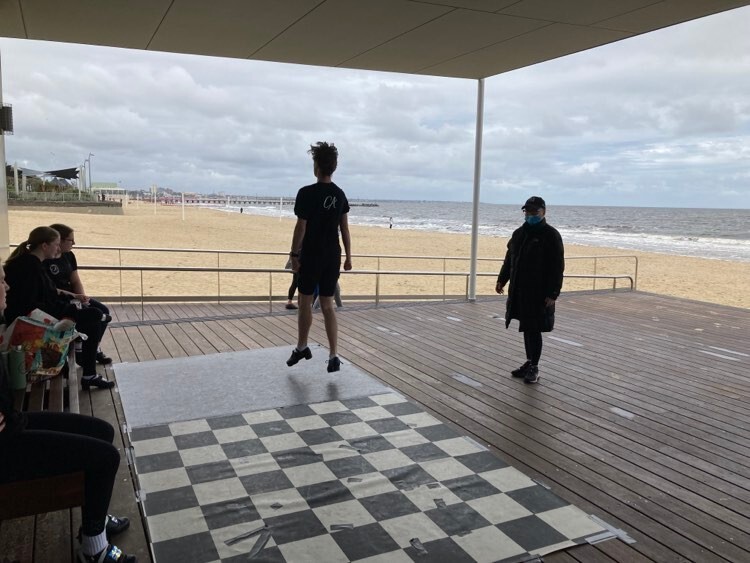 2021-10-23
2021-10-23Dancing on the Beach
As Melbourne moved out of its second winter in lockdown, my Irish dancing classes moved from Zoom to South Melbourne Beach to take advantage of the rules allowing outdoor sport training in small groups. Having to contend with the sun, wind and rain was a new experience for a very indoor activity; so was training in full view of the fascinated public. It was a spectacular chance to post on social media in the setting sun, however. The beach was packed every weeknight with people like us enjoying their outdoor exercise, more than it had ever been before the pandemic. At the rules eased and allowed more indoor activities, people disappeared from the courts and walking paths. Eventually, we returned to indoor activities too. Submitted for University of Melbourne HIST30060, Semester 2 2021. -
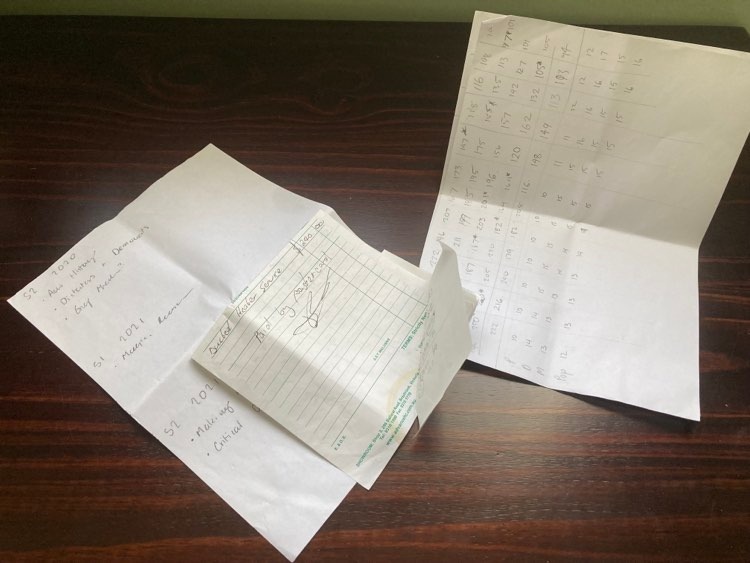 2020-08-01
2020-08-01Guessing the Numbers
As Melbourne’s second wave crested and fell in mid-2020, “the presser” was appointment viewing; “the number” could bring hope or despair. Sometime in the dreary days of lockdown, my family started guessing how many cases would be reported each day. Keeping a running tally of who was closest to the pin. Perhaps it was a way of taking control of the uncontrollable. Dealing with the apparent randomness of the numbers that controlled every aspect of our lives. Some of the scraps of paper we used to write on were time capsules of a vanished world: a rough sketch of enrolments for the second half of my BA; an invoice from a tradesman; a reminder note to pick someone up from hospital. Plans, visitors, outings – all overwritten by inexorable quotidian sameness. Submitted for University of Melbourne HIST30060, Semester 2 2021. -
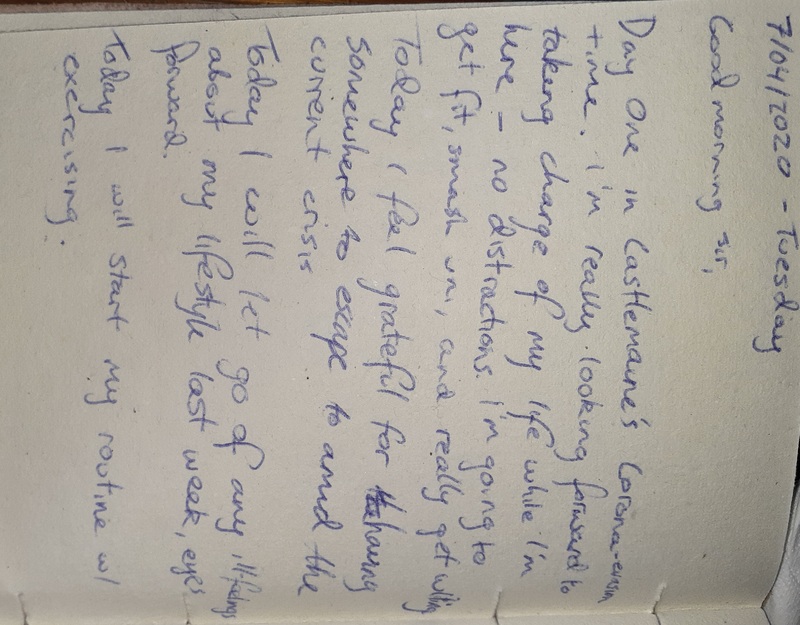 2020-04-04
2020-04-04HIST30060: Enthusiastic Journal Entry
This is a photograph from my first journal entry after lockdown began. It shows what I think was a fairly common welcomed feeling to the lockdown, before we knew how serious things would get. I recall being excited to have some time to focus on writing and exercise without the distractions of work. How quickly those feelings changed... -
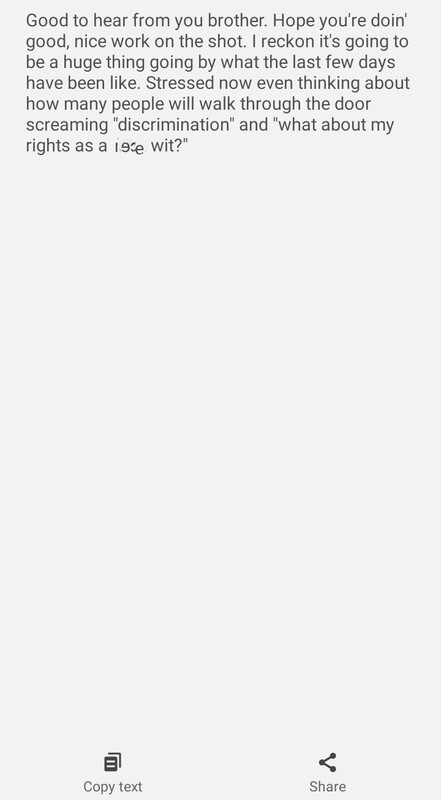 2021-10-10
2021-10-10HIST30060: Frustrated Bar Manager
This is a text message I received from the manager of the bar that I work at. It shows the frustration of beleaguered hospitality workers with the difficulties of enforcing government rules such as mask mandates and vaccination certificates as a condition of entry. -
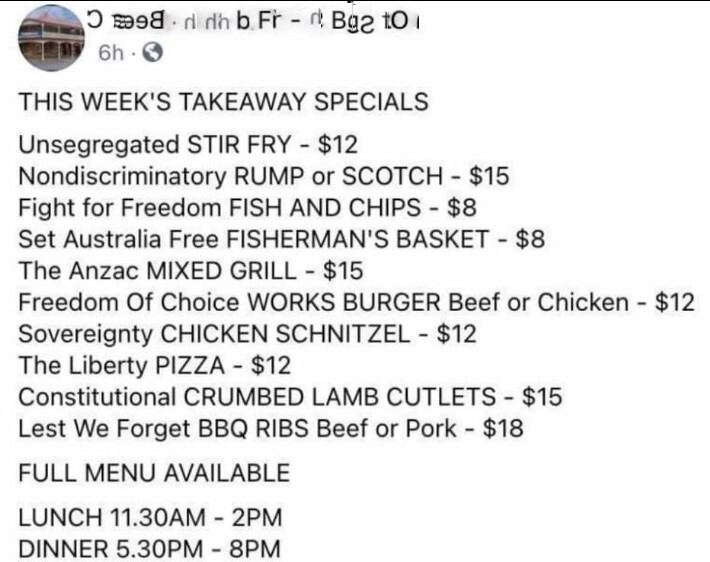 2021-04-22
2021-04-22HIST30060: Anti-Lockdown Pub Menu
This screenshot of a pub's 'freedom menu' captures the way that people's opinions lockdown measures have been expressed in strange ways. It also highlights the unusual propensity for anti-lockdown opinions to elevate their struggle to that of great civil rights movements of history with their persistent use of terminology like segregation. -
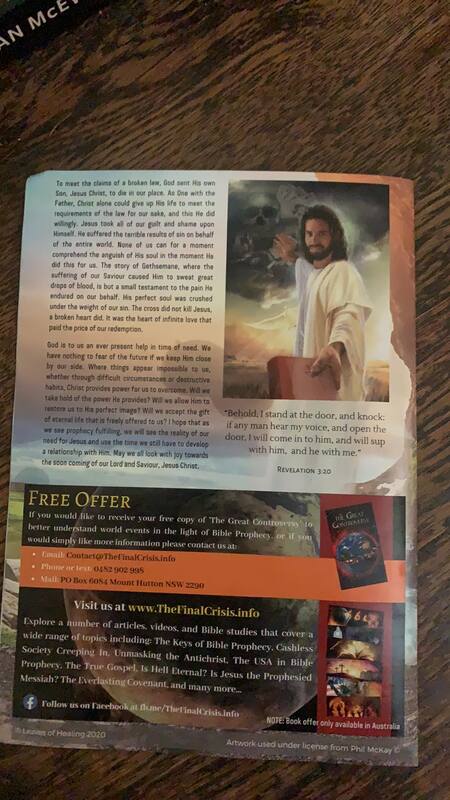 2021-10-30
2021-10-30HIST30060: Quasi-religious Anti-lockdown Pamphlet
This pamphlet was dropped into my letter box during the height of Melbourne's anti-lockdown protests. It speaks to the religious aspects of the anti-lockdown movement. -
 2021-08-30
2021-08-30Jewish Melbourne - Yiddish Choir on Zoom
The 'Mir Kumen On' Yiddish Choir, affiliated with the Jewish Labour Bund Melbourne, migrated to Zoom at the beginning of the pandemic and returned there at each lockdown and, depending on the how restrictions affected singing indoors, during non-lockdown periods. Holding choir sessions over the internet isn't easy, for example, participants are required to be on mute during songs so that there isn't lag, overlap, and interruption issues. Therefore while singing, one can only hear the pianist, Tomi Kalinski, who runs the sessions. But it's still an absolutely enjoyable time, seeing everyone and singing the soulful Yiddish songs, even if it's only to yourself. There have been some benefits too: with the online platform, Yiddish lovers from around the world have been able to join our little Melbourne choir, including from France and Scotland. The weekly zoom choir sessions have definitely lightened some of the darkest periods of my lockdown experience. -
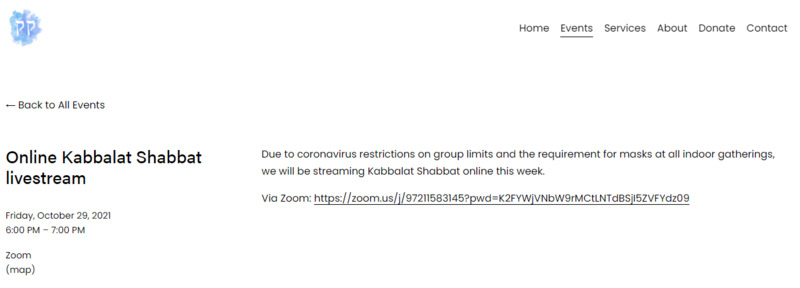 2021-10-29
2021-10-29Kehilat Kolenu Online Services - Jewish Melbourne
During the lockdowns and COVID restrictions in Melbourne, Jewish communities found ways to connect. Especially important are the Friday evening services for Shabbat. Kehilat Kolenu, a Humanistic Jewish organisation held zoom meetings in place of their usual Kabbalat Shabbat services. Especially during the loneliest, most isolating periods in my lockdown experience, these zoom meetings where I could hear the songs of my culture helped me feel spiritually and socially reconnected. HIST30060 -
 2021-09-30
2021-09-30Pro-Vax, Pro-Union Anti-Fascist Poster - Jewish Melbourne
In the wake of the anti-lockdown riots that gripped Melbourne in September 2021, the Campaign Against Fascism movement disseminated the phrase Pro-Vax, Pro-Union, Anti-Fascist. Inspired by this, Link/לינק, a zine associated with the Jewish Labour Bund in Melbourne, posted a poster to their Instagram account, of their take on this messaging, including the shouting man from early twentieth-century Bund posters. The poster was also physically published in the zine's second edition in October 2021. HIST30060 -
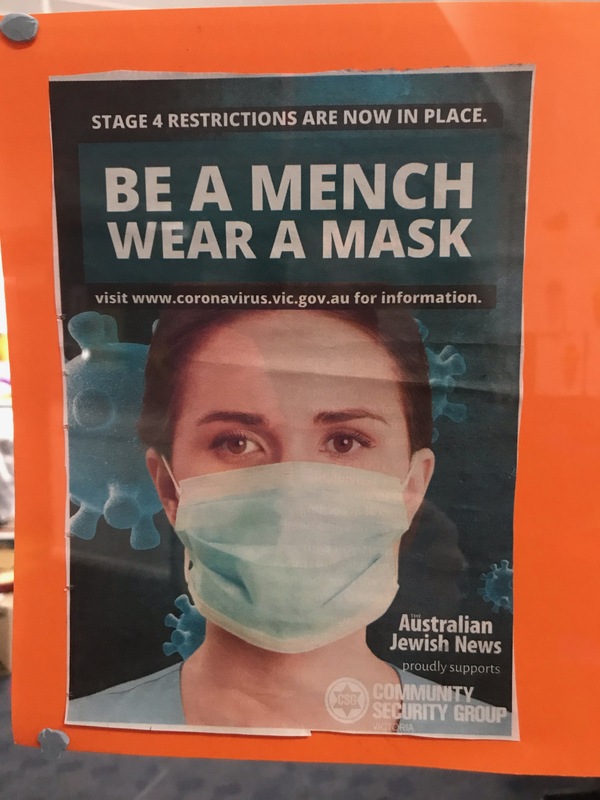 2021-11-01
2021-11-01COVID-safe posters in school - Jewish Melbourne
"Be a Mench, Wear a Mask." Sounds like a Jewish superhero slogan! This poster, using the Yiddish word 'mench' or 'mentsh,' "a person of integrity and honor," published in the Australian Jewish News has been cut out and stuck onto the door of the Jewish Studies (ייִדישע שטודיעס) office, alongside a sign expressing the limit of people inside the room. There has been unclear government mandates on mask wearing inside schools, mainly when it comes to standing at the head of a classroom, but this poster has reminded all walking past the JS office of the mask's importance throughout the pandemic. -
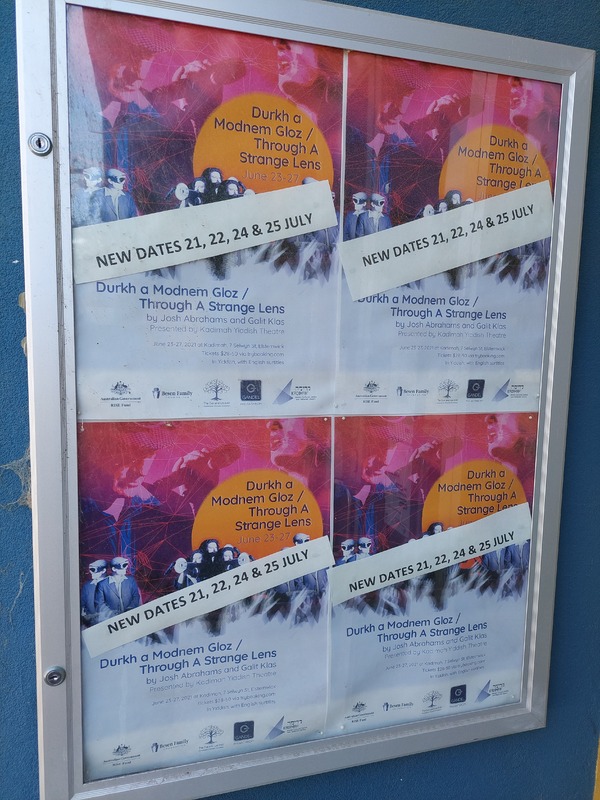 2021-11-01
2021-11-01Yiddish Cabaret Postponed in Jewish Melbourne
Melbourne's state of rolling lockdowns through the second half of 2021 played havoc with the performing arts industry. 'Durkh A Modnem Gloz' ('Through A Strange Lens'), staged by the Kadimah Jewish Cultural Centre in Elsternwick, a Yiddish cabaret performed by Galit Klas (with English translation surtitles created and operated by me) was an event that had to be rescheduled multiple times. As seen in the first image, the original performance dates were listed June 23-27, but was postponed to July 21-25 due to insufficient rehearsal time, thanks to the lockdown ending 10th June. With a new lockdown coming into effect on Thursday 15th of July, new dates were again required. In the Facebook post on the 21st of July (screenshotted and posted here), the Kadimah Jewish Cultural Centre officially announced the postponement. These new dates were set for August 4-8, but the opening night was the only show performed as Lockdown 6 was announced and came into effect on Thursday 5th. Now with that lockdown finally over, will ‘Durkh A Modne Gloz’ finally get the full season it deserves? (Uploaded as a part of my university studies: HIST30060)
